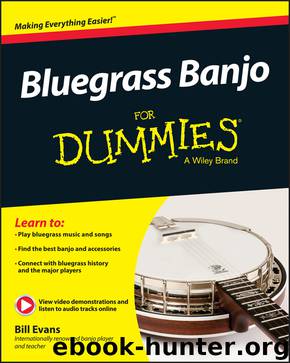Bluegrass Banjo For Dummies by Bill Evans

Author:Bill Evans
Language: eng
Format: epub
ISBN: 9781119004295
Publisher: Wiley
Published: 2015-04-20T15:05:39+00:00
Matching Rolls to Melodies
When roll patterns are added to melodies, you bring both the bluegrass and the banjo elements to the music you’re creating. It’s the crucial step that turns your banjo playing into great-sounding bluegrass music. The following section explores the ways that banjo players use roll patterns to create bluegrass banjo solos based around the melody. You discover how the notes and rhythm of the melody help determine your choice of rolls and how you can vary rolls to include as many melody notes as possible in your arrangements.
Bluegrass banjo players play a lot of notes when taking a solo, but not all these notes are melody notes. Guitar and mandolin players and fiddlers play songs primarily by using scales, but bluegrass banjo players build solos from the roll patterns themselves. When banjo players create solos in this way, they surround the melody with these notes, playing eight roll notes for every one to four melody notes (if you need to get in touch with those all-important roll patterns, check out Chapter 5). The roll-pattern notes that are not melody notes are almost always notes that are part of the chord being played at that moment in the song.
In bluegrass jam sessions, many if not most of the songs you play will be singing songs, rather than instrumentals. In these cases, it’s the bluegrass banjo player’s way to create authentic-sounding solos using roll patterns, choosing the rolls that allow you to include as many melody notes as possible while also helping to create a hard-driving bluegrass solo.
The following tips will help you to successfully integrate roll patterns into your own arrangements:
To get started, find and play the melody notes that fall on the first beat of each new chord. You don’t have to include every melody note in your solo, but if you can play the melody notes that occur with each chord change, you’ll have a tremendous head start in creating a great-sounding solo.
Choose rolls based on the rhythm of the melody. Every melody has a unique rhythm (for instance, try clapping out the rhythm to “Happy Birthday” to experience what musicians call melodic rhythm). You’ll choose rolls based on the melodic rhythm of the song you’re playing, matching the rhythm of each phrase to the most appropriate roll.
Play the melody notes louder. You want the melody notes to stand out from the other notes in your roll patterns. Don’t be afraid to put a bit more energy behind these notes to emphasize the melody in your solos.
Leave out a few melody notes to make the rolls flow. The goal is to include enough melody notes so that your listeners will recognize what you’re playing, but it’s also important to keep the rolls flowing. If you miss melody notes, or if a melody note falls in an unexpected place in the roll, no worries — simply keep rolling!
Use roll variations to grab melody notes. Think of the roll patterns as a basic framework that you can alter to get the notes you need.
Download
This site does not store any files on its server. We only index and link to content provided by other sites. Please contact the content providers to delete copyright contents if any and email us, we'll remove relevant links or contents immediately.
The Goal (Off-Campus #4) by Elle Kennedy(13207)
Kathy Andrews Collection by Kathy Andrews(11331)
Diary of a Player by Brad Paisley(7270)
What Does This Button Do? by Bruce Dickinson(5936)
Assassin’s Fate by Robin Hobb(5858)
Big Little Lies by Liane Moriarty(5519)
Altered Sensations by David Pantalony(4872)
Pale Blue Dot by Carl Sagan(4627)
Sticky Fingers by Joe Hagan(3916)
The Death of the Heart by Elizabeth Bowen(3342)
The Heroin Diaries by Nikki Sixx(3325)
Beneath These Shadows by Meghan March(3153)
Confessions of a Video Vixen by Karrine Steffans(3104)
The Help by Kathryn Stockett(3022)
How Music Works by David Byrne(2968)
Jam by Jam (epub)(2880)
Harry Potter 4 - Harry Potter and The Goblet of Fire by J.K.Rowling(2814)
Strange Fascination: David Bowie: The Definitive Story by David Buckley(2702)
Petty: The Biography by Warren Zanes(2575)
